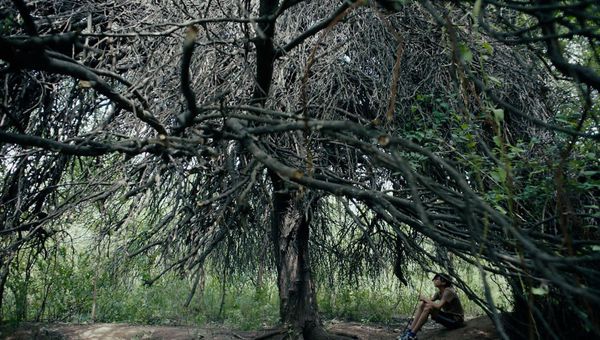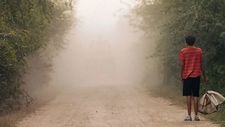 |
| Almamula |
The story of a boy - Nicolás Díaz’s Nino – whose family moves to a small village after he suffers a brutal homophobic assault, and who subsequently hears stories about a missing boy and a monster in the forest, Almamula screened as part of this year’s Inside Out festival in Toronto. Shortly beforehand, I met director Juan Sebastián Torales to talk about it. Readers should be aware that there are mild spoilers in what follows, though it’s not a film whose power depends on surprises, and it will leave you with plenty to wonder about afterwards, regardless. Our discussion began with me mentioning that I had heard the film is autobiographical.
“Yes,” Juan nods. “I like to talk about this film as an unconscious painting with images and things that I witnessed or lived or experienced or suffered, in this determining moment of my life, in puberty. I tried to put all that in a blender and give it that dark tone, because you know, that moment of life, it's like a horror film. Because with puberty you become this monster version of you. Your hair’s growing and you have this fire inside, because your sexual drive is becoming bigger.”
The assault at the start of the film is quite shocking to watch. Did he include it there to set the tone, so that there was less need to show violence later?
“Actually, I was not going to put that scene in the film,” he says. “I was going to start in the car, because it's something that we've already seen a lot. But finally, I took the decision to keep it because it's still happening nowadays. It’s something that you cannot turn your back on. You have to show it, you have to remind that it's still happening; and for the rest of the film, yeah, it's like, is this balanced or unbalanced? The really that we as LGBT members and human beings know, is incredible. One day you're oppressed, and the other day everything is normal. I thought that it was fair to do it at the opening of the film.”
The scene ends with Nino being thrown into a truck full of toads. Where did that idea come from?
He laughs. “Well, that is crazy, because I'm in Seattle now – and as I told you, this film is like unconscious moments in my brain that I took to the screen. My aunt that lives in Los Angeles came to the première yesterday and I told her ‘You're going to see frogs and toads in the film. And those frogs mean the day that your son – my cousin – he cut a frog in half with an axe in front of me, and then one of the halves started moving. And that traumatised me for life. I cannot see a frog. So I said ‘I have to beat this fear, and I’m going to make this thing with the toads and I’m going to throw this kid in with the toads.’”
 |
| Almamula Photo: courtesy of Inside Out |
There's a balance all the way through the film between realism and symbolism.
“When you grow up in northern Argentina, where I come from, where the film was shot, there is mystical and superstitious folklore that we have here. The cradle of culture – it’s the oldest city in Argentina, and we have these legends and we have these tales. And we give this importance to the forest all the time. So for me, that was the link that I could find to tell my story and give it a quirky and dark touch. And it's part of a work that I want to do, if I'm able to do it: it's a trilogy about the forest, talking about three minorities, so the LGBT community, indigenous culture, and women. And everything related to nature and forth. So this was the first try.”
I tell him that I’m interested in the forest because it seems such an overwhelming environment for Nino when he moves there, and also because there's a scene where we see one of the machines designed to destroy it coming down the road towards him. For a moment, he seems like he might be in danger from the machine. It feels as if the forest is being set up as a place where there is a different way of living, a different way of being, and then the machines fit in with the society that rejects the boy.
“Yeah, there's a bit of that,” he says. “I also considered the nature of the forest as a minority that men are destroying. That's what Nino's father's doing during the film. Nature is minority too, for me. So I could not leave this. When I was doing the investigations for the shooting of the film, I went, over ten years, to my hometown, and I saw how the forest was reducing year by year by year by year. And indigenous communities were dumped from their houses just to destroy the houses and trees and occupy the land. And this was shocking. All all through this ten years, everything was disappearing. We shot the film in a little space of forest still intact. So that's the story of the machines and nature.”
Then there is the mother's fear of the forest and the fear of the children going into the forest, which seems to be a fear of them maybe finding out something about themselves that they're not supposed to.
“Yeah, of course. First of all, that's something every mother tells you when you live in northern Argentina. As I told you, the mysticism and the superstition is everywhere. Plus there's this kid that disappeared in story, Panchito, and of course, there's fear of the mother: she doesn't want her kids to disappear, so she tells them ‘Don't go to the forest.’ But also, behind this, I always thought when I was writing the script that she knows about what the father is doing in this place. He's trying to destroy nature and he's abusing these people living there. And she closes her mouth, as a lot of religious people do. They don't say, they don't tell. The worst violence that exists is the silence that is not permitting her to help these kids, to tell them ‘It's okay what you're going through, it’s normal.’ She prefers to just shut up and be more violent.”
It’s also worrying watching Nino because he’s so desperate to find somebody like him, and it seems that he could all too easily meet somebody who would take advantage of him. There's always that kind of sense there that maybe that's what happened to the missing boy, and he's in danger like that.
“Exactly. Not in a sexual way, maybe. Yes, of course, there's these sweaty man, very muscular, that work in the forest. There's this manly thing going in the forest. But also, there's the doubt that maybe Panchito disappeared because a tree fell on his head. Or maybe these people abused him, or they took him out of his house very violently, and he lost his life like this. That's one of the options.”
 |
| Almamula |
I think the mystery makes it more powerful, I tell him.
“Yes. I went for the mystery card in several moments, and I prefer it like that.”
In terms of Nino’s desires, something which is addressed explicitly in the film is his excitement over the figure of Jesus Christ.
“It was very explicit,” he nods. “Yeah, growing up in the family I grew up in, the only naked man that I had around the house was Jesus. He was always this beautiful man, very white, very blonde. And why was he blonde? Why always white? He can be black. I don't know. Yeah, that was the image that we had. And that was the image of a beautiful, nice, caring men that I had. And that excited me in that moment.” He blushes.
There’s a scene where the women of the village are discussing a statue of Christ and it seems that they feel the same way, which makes an interesting contrast.
“Yeah, it's my favourite scene of the film, that one.”
And then contrasted with that there’s the idea of the Almamula, who is depicted in a painting which Nino and his sister remember being afraid of. I liked that because it reminds us how young they are.
“Yeah, I tried to not lose that ingredient, that they're still young. They still have their fresh memory of their younger years and in some ways you can understand what kind of things they're confronting. Nino is is living one of the most difficult moments of his life and everything around him is falling apart, everything around him is wrong. I mean, it's not wrong. It is what it is. But they try to make him think that he’s wrong. And actually he's not doing anything but the bad things are happening around him. So this is, what these young boys are confronting. That's why was important to show the fresh, young feelings.”
We talk about the Almamula itself.
“If you go to on the internet, and you put ‘Almamula’ in, it appears like a horse which throws fire from his mouth and carries chains, a big monster. What I wanted was a woman to embody this – a very skinny, black, wooden skinned woman with red eyes. It’s because for me, woman is future. And finally, this woman who was punished like that, because she was living her sexuality freely, transformed in a monster. I don't know if that would have done the same thing to a man, because he was living his sexuality freely. So I chose a woman to embody this as a salvation for us, which is minorities, we help each other. ‘If you find me, I will take you with me.’ So that's, that's the metaphor behind why I chose this monster and why she is shaped like a woman. Maybe it's the door for the next movie.”
It also seems that Nino may be learning to accept the things about himself which people claim are monstrous.
“Of course, of course. This last image is like, he sees the Almamula but at the same time, it's like a mirror. They're both skinny. They have the same height, you know? They're face to face and yes, there's this connection between them. Maybe yeah it's Nino watching himself and accepting himself. Now of course, everything in this film is ambiguous.”
Does find new things in the film now that it's done?
“Oh yes. The thing is, when you deliver a film like this, that is so ambiguous, and that is quite an experiment that I had the chance to do – because it's not easy to make these kind of films, if there's no A to Z. The audience after each screening comes and they tell what they felt. They tell ‘Okay, so he suicided himself.’ If you want, he did that. I'm always amazed. I really rediscover the film each time I have a screening.”
How does he feel about it being selected for Inside Out?
“Being at Inside Out for the screening, I'm super excited. I have a very close friend that lives in Toronto. It's been ten years. I told her that I wanted to come to see her. When I learned that I was selected, I said ‘Amazing!’ And this is one of the largest, most important LGBT festivals in the world. I mean, it's very important, of course, having a film like this and hoping to find people that will connect with it, and that will get the message and live the experiences and story in a country so far away from Argentina. You are always excited to see what the reaction of the audience will be, but with this film, especially, because of everything I told you about this experience.”





















